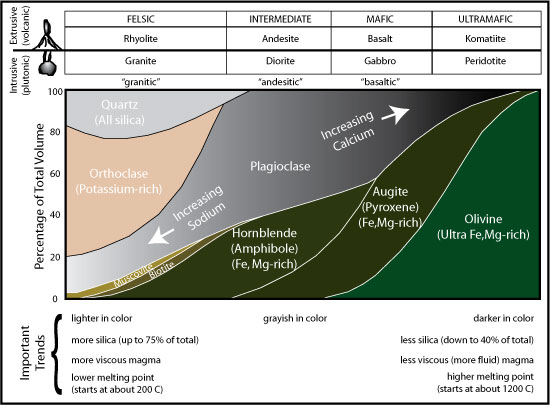One way to classify rocks is by the amount of silica (sand, silicon dioxide, SiO2 in chemical lingo), they contain. In addition, it is generally the case that the rocks with a lower proportion of silica also tend to contain more magnesium and iron, whereas rocks with higher silica content tend to have a preponderance of lighter elements such as calcium, sodium, potassium or aluminium. It comes as something of a surprise therefore that the high silicate types sometimes occur in regions where the lower silicon type seems to be the only obvious source of the lighter (in both density and colour) high silicate rocks. This puzzling juxtaposition even has it’s own name, it is called the “andesite problem”. This seemingly out of place andesite, and its analogue, diorite, have a silicate content that is midway between basalt (lower) and granite (higher).
Below is a graphical presentation showing how silica in the various rock types ranges from 40 to 75 percent. It also shows how viscosity, colour and melting point vary along with the silica. The relationship between silica and the lighter elements is also apparent.

Credit: http://www.geojeff.org/igneous-compositions.html
It’s not just some academic issue that has little relevance to people’s lives, just the opposite in fact, for andesite is both a blessing and a curse in that andesite volcanoes are the most dangerous to life and limb as they tend to erupt explosively. This is mainly due to the differing viscosities of the high and low silicate rocks, high silicate andesite magmas are thick and flow slowly while the lower silicate basalts tend to flow freely. This translates to higher pressure eruptions for andesite, …it is harder for any gases present to escape so the pressure can reach higher levels. And on the blessing side, andesite hosts many of the elements, copper for example, that enable much of the modern technology that we currently enjoy. So given its far reaching effects it is natural that we would be curious about their origins and whatnot.
The question of their origin has been the source of much discussion and a number of explanations have been suggested. Researchers generally try to reconcile the relative amounts of certain trace elements or minerals, notably zircon, zirconium silicate ZrSiO4, and the oxide of phosphorus P2O5, contained in the mineral apatite), in the proposed precursors with the amounts present in the andesites.
They include:
– A process known as crystal fractionation or differentation of hot mantle rock or submerged crust, where the higher melting point minerals crystallize first leaving a solution that is enriched in the lower melting point minerals. This liquid plus crystal mush then separates with the heavier mineral crystals tending to sink, leaving the still liquid high silica, lower melting point minerals to occupy the upper regions of the melt. The liquid portion is then free to move towards the surface where it solidifies to create andesite islands in a sea of basalt, …literally. The sea of basalt is the ocean crust and the andesite islands are the intra-ocean island arcs that occur where two separate parts of the ocean crust meet with one part of the crust overriding the other or to put it another way with one section sinking beneath the other.
-Mixing of ocean floor sediments with the down going basaltic ocean crust or overlying mantle wedge rocks (peridote) to produce a hybrid melt which then becomes the source of the andesite. This method would require the relatively high zircon content of sediments to be reflected in the andesite that is produced from the resulting mixture. however this is generally not observed (this link also outlines shortcomings with the other models mentioned below).
-Mixing ocean crust basalt with high silica “end members” such as dacite or rhyolite. Again there are problems with actual zircon and phosporus values vs those expected from the model.
-Various types of crust mantle mixing. Again the numbers don’t add up.
None of the proposed mechanisms or combinations thereof are all that convincing. All the mixing explanations also suffer from the differing liquidus and solidus temperatures of high and low silica melts as the higher temperature low silicate melts are apt to solidify on contact with the higher silicate melts. It perhaps suggests the presence of an active energy source to maintain the liquid nature of the components. Interestingly the radio isotope signature of the andesites and continental crust are similar. But again there are major inconsistencies.
… Because the relatively enriched signature of radiogenic isotope composition is generally comparable between andesites and their emplaced continental crust, the crustal contamination at the crust-mantle transition zone is often envisaged in the hypotheses for andesite petrogenesis.
However, these hypotheses are not compatible with quantitative constraints from the mass balance of major elements, trace elements and their pertinent radiogenic isotopes in andesites.
Some energy source other than compression/convection/dehydration and disseminated isotopic activity may be able to provide a more compelling narrative about this important phenomena.